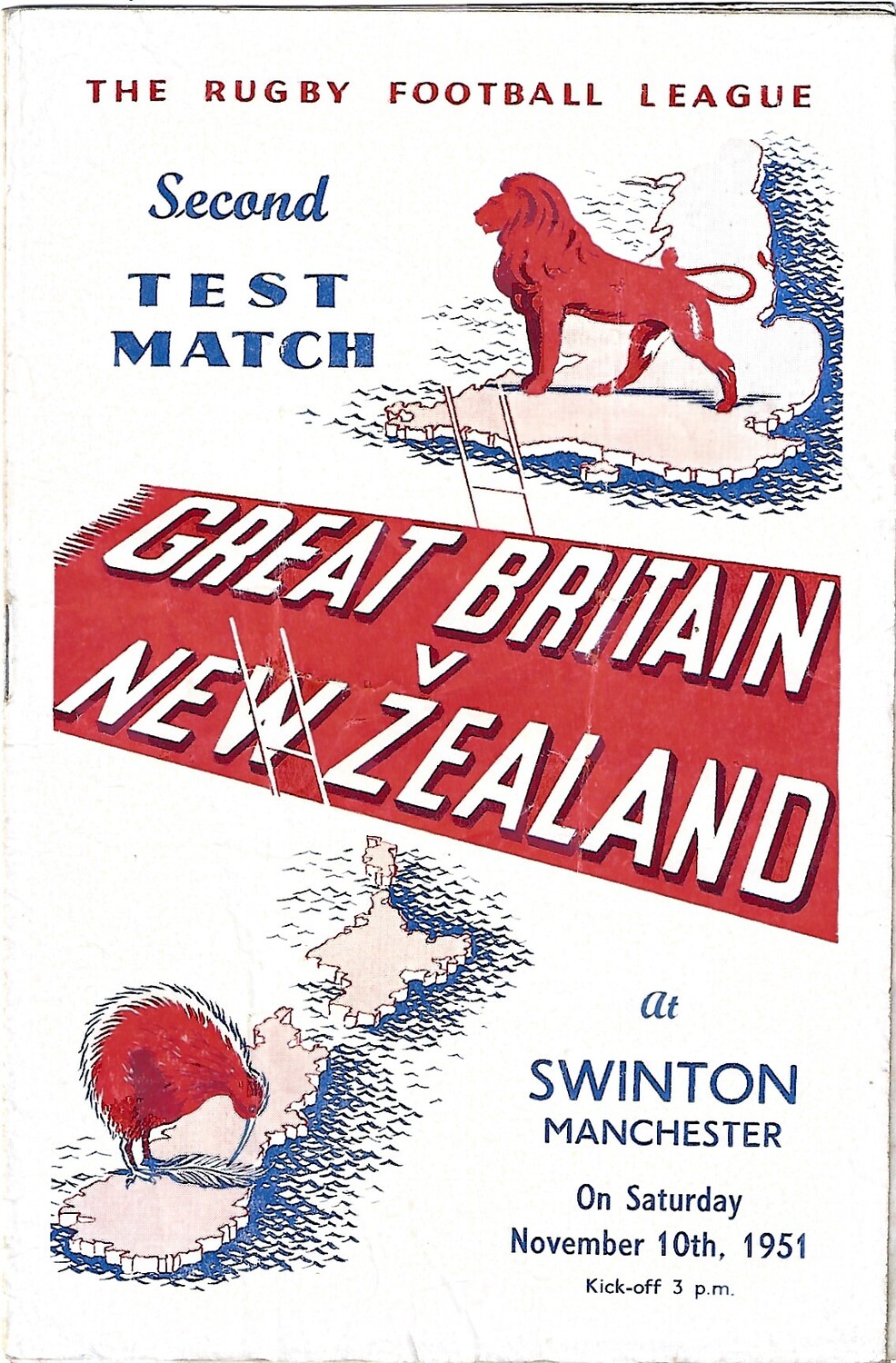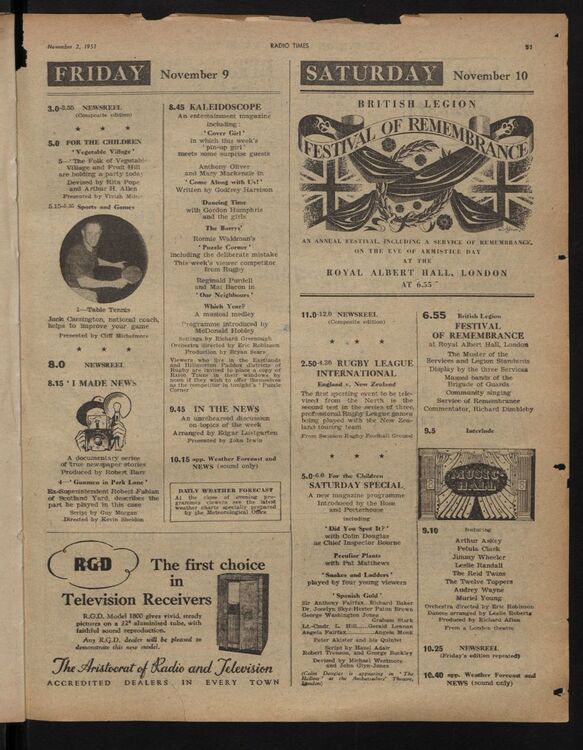Great Britain 20-19 New Zealand (partially found footage of international rugby league game; 1951)
Between 6th October to 15 December 1951, as part of New Zealand's 1951/52 tour of the United Kingdom and France, Great Britain hosted the Kiwis for a best-of-three rugby league test series. The second, occurring on 10th November in front of 29,938 at Station Road, saw the Lions narrowly overcome New Zealand 20-19 thanks to a late and controversial penalty conversion by Jimmy Ledgard, contributing towards Great Britain achieving a 3-0 series whitewash. The game was televised live by BBC Television Service; it not only became the first international rugby league game to be televised live, but additionally proved historic for being the first outside broadcast of sport witnessed by the North of England.
Background
Heading into the Kiwis Tour, New Zealand sought to avenge their 1947 Tour loss to the Lions, which saw Great Britain win the series 2-1.[1] However, Great Britain was certainly demoralised following their 2-0 1950 Lions Tour loss to New Zealand, and therefore also had plenty to play for in the upcoming series.[1] Aside from the best-of-three series, New Zealand also competed against various sides in England and Wales.[2] Not counting the series, New Zealand won 18 games, including a victory against the Welsh national team, and endured six losses.[2] The first Lions-Kiwis match commenced on 6th October with 37,475 in attendance at the Odsal.[3][4] After leading at halftime 8-5, the hosts wound up 21-15 winners, primarily thanks to three tries from George Wilson, three goals by Ken Gee, and additional tries from Dick Cracknell and Doug Greenall.[3][4][2] Cyril Eastlake, Cliff Johnston, and Maurie Robertson scored tries for the Kiwis, with Des White matching Gee's goals scored.[3] Additionally, some British newspapers cited Cec Thompson's inclusion into the Great Britain squad as noteworthy, for he became the second black player to play for the Lions.[5]
The second test commenced on 10th November, with Station Road featuring a crowd of 29,938.[6][4] In a significantly closer affair, New Zealand gained the upper hand in the first half, having led 11-7.[7][6] Britain fought back in the second, but with only a few minutes to go, still trailed 18-19.[7] Bruce Robertson's two tries, alongside ones by Cyril Eastlake, Jack Forrest, and Charlie McBride, helped the Kiwis build a slender lead.[6][7] The Lions in comparison scored four tries, achieved by Cracknell, Vince McKeating, Ken Trail, and Wilson.[6][7] What kept the Lions in the game was Jimmy Ledgard's conversions, with him beating White 3-2 in the final few minutes.[7][6] Suddenly, in a decision that courted controversy, the Lions earned a late penalty.[7] This was converted by Ledgard to put his side 20-19 in front, which ultimately proved to be the final score.[7][6][4]
With the Lions having already secured the series, they aimed to achieve a whitewash on 15th December.[8][4] 18,649 attended the Headingley, which saw the Lions dominate the first half 13-6.[8][4] GB's scoresheet consisted of two tries from Andrew Turnball, in addition to Billy Blan and Wilson's solitary contributions and Ernest Ward's two goals.[8] New Zealand improved in the second half, Jim Edwards' two tries having been bolstered by Hough and Mulcare's singles.[8] Alas, a lack of goals scored cost the Kiwis the tie, losing 12-16 and condemning the team to a 3-0 series loss.[8][4] New Zealand's performance did not improve during its two-game series against France, losing the encounters 3-8 and 7-17 respectively.[9][2] Nevertheless, the Kiwis achieved seven victories, one draw, and two losses in its other games during its 1952 Tour.[2]
Television Coverage
Before this test series commenced, the BBC had previously covered the 1948 Challenge Cup Final between Wigan and Bradford Northern.[10][11] Further rugby league television broadcasts proved limited, as not only was the BBC rumoured to have prioritised rugby union over it, but the Rugby Football League (RFL) were concerned television coverage could reduce stadium attendance.[12][11][7] This was intensified by the fact all matches exclusively occurred on Saturday afternoons, which led to competition between televised and non-televised games.[7] However, the second test game proved one of four rugby league matches to be broadcast during the 1951/52 season, subsequently becoming the first international encounter to be televised.[11][5][10][12][7] Based on the synopsis provided by Issue 1,460 of Radio Times, the entirety of the game was aired live.[13][14] Rather oddly, Radio Times stated the match pitted England against New Zealand.[13][14][10]
There was special motivation from both the BBC and RFL regarding the game's broadcast.[10][12] A major factor in the BBC's reluctance to televise rugby league games was that its Television Service signal was restricted to London and the edges of the home counties.[10] Rugby league was traditionally viewed as a sport primarily enjoyed by the North of England and was relatively unknown further down south.[10][12] Thus, concern arose that the limited television viewership would find rugby league confusing and unappealing compared to rugby union.[10] This was no issue by 1951, as the BBC had greatly expanded its television signal's range.[15][16][10] For instance, 1949 saw the erection of the Sutton Coldfield transmitter, allowing broadcasts to reach the Midlands.[15][10] Two years later, on 10 October 1951, the Holme Moss transmitter was opened, thus finally granting Northern England access to BBC television.[16][10]
Suddenly, BBC's coverage needed to appeal to a significantly bigger and more diverse viewership unlike in 1948.[10] On the sporting front, rugby league was declared perfect for the BBC's inaugural outside broadcast of a sporting event in the North of England.[10][13][14] The fact the encounter was an international game likely avoided alienating any area of the country, and in turn, united the television audience in cheering on the home side.[10] The second test's close and exciting play delighted the BBC, though the RFL baulked at how Station Road saw a reduction of ground attendance totalling more than 9,000 compared to the Odsal game.[7][11][12][4] It should be noted that the untelevised third test drew even fewer fans, over 10,000 to be precise, though this could have been because the series was already wrapped up.[7][4]
Ultimately, the RFL cited declining attendance levels for domestic and international matches as the reason behind restricting television coverage over the next few years.[12][11][7] Coverage became more regular in the late 1950s when studies proved television exposure actually did little to damage motivation in seeing games in person.[11][12] Despite the RFL's tightening restrictions surrounding British rugby league broadcasts, the BBC were able to cover the 1954 Rugby League World Cup Final in France, which saw Great Britain defeat the hosts 16-12.[11][12]
Availability
The second match was televised live during the infancy of telerecordings.[17][18][19] Some BBC recordings of sporting events had materialised as far back as 30 November 1949, when a few minutes of the England-Italy international football match were successfully preserved.[18] However, recordings rarely occurred until the BBC started harnessing videotape as its main source by the late-1950s.[17][19] Ultimately, the match is unlikely to have received one of those lucky early recordings. Nevertheless, some footage of the best-of-three series can be viewed via newsreels.
Gallery
Videos
Image
See Also
- 1924 NSWRFL Premiership Final (lost radio coverage of rugby league game; 1924)
- 1927 Challenge Cup Final (lost radio coverage of rugby league game; 1927)
- 1948 Challenge Cup Final (partially found footage of rugby league game; 1948)
- 1954 Rugby League World Cup Final (partially found footage of international rugby league game; 1954)
- Christchurch vs High School Old Boys (lost radio coverage of charity rugby game; 1926)
- England 11-9 Wales (lost radio coverage of Five Nations Championship game; 1927)
- England 16-21 Scotland (partially found footage of Home Nations Championship game; 1938)
- North Sydney Bears 19-21 Balmain Tigers (lost footage of NSWRFL Premiership season game; 1961)
- Scotland 21-13 England (lost radio coverage of Five Nations Championship game; 1927)
References
- ↑ 1.0 1.1 New Zealand Rugby League summarising the results of the New Zealand national rugby league team. Retrieved 7th Sep '23
- ↑ 2.0 2.1 2.2 2.3 2.4 Rugby League Project detailing the results of the Kiwis Tour 1951/52. Retrieved 7th Sep '23
- ↑ 3.0 3.1 3.2 Rugby League Project detailing the results of the first game. Retrieved 7th Sep '23
- ↑ 4.0 4.1 4.2 4.3 4.4 4.5 4.6 4.7 4.8 Rugby League Project summarising the best-of-three series. Retrieved 7th Sep '23
- ↑ 5.0 5.1 The Guardian obituary of Cec Thompson, which noted he was the second black player to represent the Great Britain national rugby league team. Retrieved 7th Sep '23
- ↑ 6.0 6.1 6.2 6.3 6.4 6.5 Rugby League Project detailing the results of the second game. Retrieved 7th Sep '23
- ↑ 7.00 7.01 7.02 7.03 7.04 7.05 7.06 7.07 7.08 7.09 7.10 7.11 7.12 Archived TotalRFL summarising the second test and its television significance. Retrieved 7th Sep '23
- ↑ 8.0 8.1 8.2 8.3 8.4 Rugby League Project detailing the results of the third game. Retrieved 7th Sep '23
- ↑ Rugby League Project summarising New Zealand's best-of-two series with France. Retrieved 7th Sep '23
- ↑ 10.00 10.01 10.02 10.03 10.04 10.05 10.06 10.07 10.08 10.09 10.10 10.11 10.12 BBC Sport in Black and White summarising the BBC's broadcast of the second test and its historical significance. Retrieved 7th Sep '23
- ↑ 11.0 11.1 11.2 11.3 11.4 11.5 11.6 Rugby League in Twentieth Century noting the second test was one of four 1951/52 games to be televised, and how concerns regarding ground attendance limited coverage throughout much of the 1950s. Retrieved 7th Sep '23
- ↑ 12.0 12.1 12.2 12.3 12.4 12.5 12.6 12.7 Transdiffusion summarising the BBC's coverage and the concerns surrounding television's impact on stadium attendance. Retrieved 7th Sep '23
- ↑ 13.0 13.1 13.2 BBC Genome archive of Radio Times issues detailing BBC's coverage of the second test. Retrieved 7th Sep '23
- ↑ 14.0 14.1 14.2 Issue 1,460 of Radio Times listing the coverage of the event. Retrieved 7th Sep '23
- ↑ 15.0 15.1 Transdiffusion detailing the 1949 launch of television in the Midlands. Retrieved 7th Sep '23
- ↑ 16.0 16.1 The Guardian reporting on television reaching the North of England. Retrieved 7th Sep '23
- ↑ 17.0 17.1 BBC noting it did not start regularly recording its television output until it harnessed videotape from 1956 onwards. Retrieved 7th Sep '23
- ↑ 18.0 18.1 BBC Genome Blog noting the oldest recording of football during the infancy of telerecording. Retrieved 7th Sep '23
- ↑ 19.0 19.1 Web Archive article discussing how most early television is missing due to the lack of directly recording television. Retrieved 7th Sep '23

